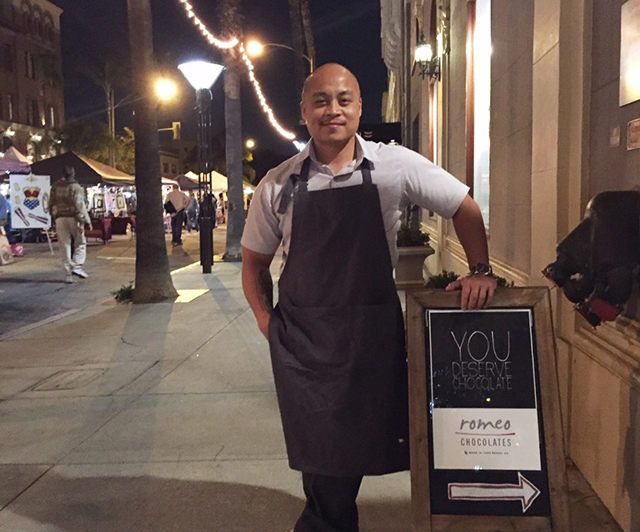/ Chocolate Resources / Chocolate Blog / Where will your chocolate “pop-up” next?

Where will your chocolate “pop-up” next?

When you are starting your chocolate business, one of the biggest decisions you will make is the strategy or strategies that you will use to sell your product: Wholesale? Retail? Through a bricks and mortar location, or online? A combination of some, or all of these strategies? Each one comes with its own set of costs, as well as pros and cons.
Many business have implemented “pop-up” shops as a retail strategy. You may have seen a big, splashy pop up shop done by a major retailer in your area, especially around specific holiday seasons. But this strategy can also be implemented on a much smaller scale. A pop-up shop is essentially just a temporary retail location. It can be as simple as a kiosk in a mall or something on a bigger scale, such as a large booth in an existing shop. It can even be a temporary “takeover” of an existing brick and mortar location.
To find out more about using pop-up shops as a retail strategy in the chocolate business, I spoke to two Ecole Chocolat graduates – Amy Jo Pedone from Valenza Chocolatier in Costa Mesa, California, and Romeo Garcia from Romeo Chocolates in Long Beach, California.
First, a little background
Amy Jo Pedone left a career in commercial real estate finance lending to pursue her passion for chocolate. She completed the Ecole Chocolat Professional Chocolatier and Master Chocolatier in Italy programs in 2011 and 2013 respectively. She opened her business Valenza Chocolatier in Cosa Mesa, California. She operates her business primarily out of The Hood, a combination of commercial kitchen space and market. She also sells her products online, and does custom orders.

Amy Jo looking festive at her holiday pop-up! Photo: Anne Watson Photography
Romeo Garcia left a career in post-secondary education administration to launch a chocolate business in 2014. He also completed the Ecole Chocolat Professional Chocolatier and Master Chocolatier in Belgium programs. His business Romeo Chocolates is based in Long Beach, California. Currently, Romeo doesn’t work out of a commercial kitchen. The state of California passed the Cottage Food B Law in 2013, which allows artisanal makers to produce certain approved food and goods at home. Under this law, there is a different type of permitting that does not require a commercial kitchen as long as the Health Department visits and approves of the home kitchen, food preparation, and packaging. As long as all items are sealed and packaged, these goods can be sold with retail partners. Romeo also does custom orders. Cottage B doesn’t allow Romeo to do any shipping.

Romeo Garcia getting ready for a pop-up! Photo: Halfway Blind Photography
Why use pop-up shops as a retail strategy?
For both Amy Jo and Romeo, the decision to use pop-up shops in their retail strategy came from a desire to be fiscally conservative as a new business. A pop-up shop gives you the opportunity to sell your product within a retail environment without taking on all the financial overhead of a bricks and mortar location right out of the gate. Pop-up shops also give you something incredibly important – face time with your customers, and the opportunity for them to meet you and taste your product. This is your opportunity to turn tasters into buyers, and buyers into repeat customers.
“Customers want the back story. There is a movement towards shopping small and shopping local. They want to get to know the proprietor, and once they connect with you and love your product, they become your brand ambassadors” says Amy Jo.

Valenza Chocolatier Fall Pop Up Display! Photo: Anne Watson Photography
Romeo has been able to take advantage of this movement as well: “There is a lot of local support and a renaissance of artisanal and hand-crafted goods in Long Beach, so there were several retail partners who encouraged me, and invited me to pop-up in their shop to promote my chocolates. Most importantly, it gave me the chance to share the story of the vision behind my chocolate company. At these pop-ups, customers have an awesome curiosity about where the chocolate is sourced from, how it’s made, and what made me personally choose this path. It makes for great dialogue and I feel it allows customers to take part in the journey with me”.
You’ve decided you want to “pop up”, now what?
Both Amy Jo and Romeo typically have between one and four pop-up shops each month. They also plan pop-up shops around major “chocolate” holidays – the winter holiday season, Valentine’s Day, and Easter, and Mother’s Day.
We all know the old adage “location, location, location”, and this is especially true of pop-up shops – you really have to do your homework. Amy Jo knew that farmer’s markets weren’t the right fit for her because she sells a higher end product, so she had to look for retail partners that had the right clientele for her products: “Farmers markets give you a steady flow of traffic, but you have to know whether people are likely to buy your product.” Initially she was able to be part of a monthly artisan program at her local Williams Sonoma that allowed retailers to set up booths at their stores. This was a great foray into the world of pop-up shops until her commercial kitchen also got its market license. Now she is fortunate enough to be able to have her pop-up shops in the same location as her commercial kitchen. This is a huge advantage when you’re dealing with chocolate, which can be a very delicate product to transport, especially during warmer months.

Valenza Chocolatier products on display! Photo: Anne Watson Photography
Romeo knew that Long Beach’s artisan scene was a perfect fit for his product, and was able to find partners who invited him in to their establishments to showcase his products: “Most of my pop-up events coincide and rotate with special events such as Art Walks, Neighborhood Festivals, and reoccurring theme nights with live music and heavy pedestrian traffic. Pop-up events are usually 3-4 hours, which allows me plenty of time to offer samples, talk about the products, and encourage sales for the retailer”.

Lavender bonbons from Romeo Chocolates Photo: Deney Tuazon Photography
Along with the physical location, you have to make sure you do your homework in relation to any retail establishment you may be partnering with. What kind of agreement will you establish with them? Do they have a good reputation? Who are their customers and how do they match with your customers? What time of day will the pop-up be held? Will you be one of many retailers at the pop-up? Will there be other chocolate there, or other sweets? Where in their establishment will your pop-up be situated – in a prominent or a tucked away location?
Amy Jo has had both positive and not so great experiences with retail partners. On Valentine’s Day and Mother’s Day, she has partnered with a local jeweler, creating a “one stop shop” for gift giving for those holidays, which was very successful for her. However, she also had a retailer cancel on her at the last minute and leave her with a bunch of product: “I had promoted the pop-up shop, so it looked like I just didn’t show up” said Amy Jo.

Amy Jo’s beautiful product display at a holiday pop-up shop Photo: Anne Watson Photography
Romeo also is careful to learn a lot about the retailer that plans to host him: “Conversations with the retailer before the pop up are critical. It helps me to understand how much product they anticipate I will sell, what price points work well, what types of packaging attracts customers, and what will be peak times for customer traffic. Are there any special events happening in their store that would help to maximize exposure to a larger audience? If it is a holiday, I would also consider if I need to do special packaging, for Mother’s Day or Valentine’s Day for instance, or prepare gift sets to meet the interests of their customers. If it is a beer & wine retail partner, I then consider what products I could bring that would pair well with the items sold in that shop”.
Promoting your pop-up shop is also a critical step. Romeo typically uses social media to promote his pop-up shops, and he also incorporates the retailer hosting him into his promotion strategy: “I work to cultivate a mutually beneficial relationship with the retailer by cross-promoting their shop and their products as I promote my pop-up event on social media”.

You Deserve Chocolate! Romeo’s delicious chocolate bars ready to sell Photo: Romeo Chocolates
Amy Jo also promotes her regular pop-ups on social media. She has also worked to put her business on the radar of local media: “One of the best things I did early on was to figure out who the main food bloggers, journalists, magazines, etc. are in my area that fit with my product and customer demographic. I invited them all to a media event so that they could try my products. Now that I’m on their radar, they help to promote my pop-ups and products too”. Creativity is key for promotion when you have a limited marketing budget. Amy Jo also often holds a giveaway at each pop-up shop, which gives her a valuable list of email addresses of potential customers!
What are some of the advantages of using pop up shops as a retail strategy?
- Pop-ups create many of the advantages of a bricks and mortar location, without all of the overhead costs
- Pop-up shops are a great litmus test for your products and market to help you get further towards a bricks and mortar location, if that is your end goal. You’re creating an identity for your brand, and giving people a chance to fall in love with your products
- Pop-ups can bring some exclusivity for your brand – people are only able to physically shop for your products at specific times/places. Romeo says: “As I organically build more of a following, I am grateful that customers are becoming repeat customers as they follow where I will pop up next”. And Amy Jo has found the same thing: “As I build a following, I have customers who come to every pop up event to see me and buy my products”.
- Learn about customer demographics, micro-neighborhoods, emerging trendy hot-spots
- Get feedback on flavor profiles and packaging
- Wide range of customers
- Flexible schedule – you’re not tied day in and day out to retail hours
- Networking and synergy opportunities with other businesses

Raspberry bonbons from Romeo Chocolates – Photo: Deney Tuazon Photography
What are some of the challenges of using pop up shops as a retail strategy?
- You will often be asked “where is your shop?” and you need to be prepared with a good answer for this question, you don’t want your business to seem transient
- Romeo and Amy Jo are producing fresh, high quality fine chocolates. They don’t use any preservatives. If for some reason the pop-up shop doesn’t go well, you can be left with a lot of product
- For Romeo: “Since locations are nomadic and I operate with a Cottage Food B permit, everything must be sealed and packaged, even individual bonbons and samples. This takes away from the aesthetic of beautifully presented bonbons that people can hand-select in usual brick & mortar chocolate shops. Also, cottage food B limits certain ingredients so the variety in confections is compromised until I expand to a commercial kitchen or my own shop in the future”.
- For Romeo: “Temperature control in transport and at the pop-up event is challenging! Since I don’t have my own shop where I can moderate the temperature, I need to make sure that the chocolate doesn’t melt en-route to the event or that I don’t set up my display in a sunny or hot area”.

Romeo ready for a pop-up at Twig & Willow in Long Beach Photo: Twig & Willow
10 best tips for planning a successful pop up shop
- Communicate early with your city’s Health Department about what are allowable products. Ensure that you have any permits required to sell your product.
- Know your capacity and set realistic timeline for production, packaging, and preparation leading into the pop-up event.
- Use pop-ups to drive traffic to your website and blog via a newsletter sign-up. This will generate direct sales on your website and leads for custom orders.
- Become comfortable with social media, such as Facebook, Twitter and Instagram. Curate pictures and stories about your chocolate creations and background story. Get people excited about your vision, brand and visiting your next pop-up!
- Set a consistent outreach schedule to promote on social media, word of mouth, and through your website. If you don’t promote your event early or often enough, it will likely directly impact customer turnout.
- Set up your display and design of your pop-up as you would your actual shop. Create an aesthetic that mirrors your brand values and image.
- Build relationships with other micro- and small- pop-up businesses to build community and to collaborate on events. Partner with the Small Business Development Center for guidance and support.
- Cultivate relationships with retailers, listen to their feedback, always thank them for their support, and treat them with as much chocolate as possible!
- Appreciate the learning curve! Pop-ups are a great opportunity to learn more about the chocolate industry through retailers, customers, and colleagues. There is always more to learn as you continue to cultivate your passion for chocolate, hone your craft as a chocolatier, perfect your products, build an identity for your brand.
- Have fun! Most retailers and customers are ecstatic to support you and want you to do well! People are usually in a great mood when buying and enjoying chocolate! Enjoy the pop-up event, relish the moment of your vision coming to fruition, and immerse yourself in a community that loves fine chocolate!

Golden bonbons from Valenza Chocolatier Photo: Anne Watson Photography
Parting words of advice
Do your homework – research your location and potential retail partners so you know exactly what you are getting into. Seize the opportunity to interact directly with customers and build your brand. And relish the moments when you see smiles on their faces when they try your products!
Follow Amy Jo and Romeo on social media to find out where and when they will be popping up next!
Valenza Chocolatier is on Facebook, Twitter & Instagram
Romeo Chocolates is on Facebook & Instagram
Have you ever held a pop up shop? How did it go? Any advice to add, or questions to ask? Tell us about it in the comments section!
Update: We had so much interest in this topic after this post that we decided to have a more in-depth conversation with Amy Jo and Romeo on one of our Ecole Chocolat Chocolate Masters Hangouts on Google+! Watch the video of this informative conversation!
Chocolat Chocolate Masters Videos! Watch the video of this informative conversation!
Want to learn more about making delicious chocolates and confections? Check out our Professional Chocolatier Program!
Get reminders about upcoming classes! To receive program updates and news, click the link below.
Photography by Jessica Washburn, Bliss Chocolatier and Ecole Chocolat





